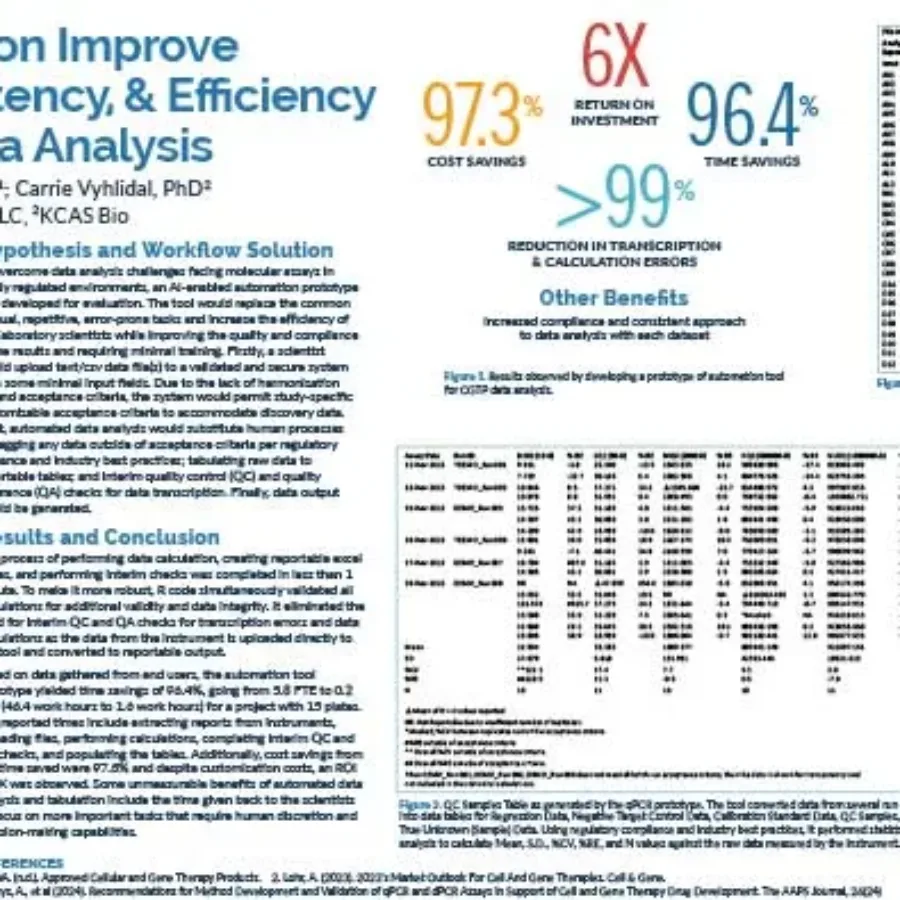 Podcasts
Podcasts
Let’s face it – nobody likes batch effects (unless it has to do with cookies, but that’s for another podcast). In episode #9 of “The Conversational Flow”, Brian and Adam talk about Batch Effects which is when you’re having changes in the study that are not necessarily related to the…
 June 20
- June 21
June 20
- June 21
The age of therapeutic conjugation is upon us! Bioanalysis for support of next generation Antibody Drug Conjugates (ADCs) and Antibody siRNA Conjugates (ARCs) have exploded recently due to the efficacy and safety that these therapies offer for immuno-oncology, rare diseases, vaccines and potentially many other diseases. Recently, we have seen…
 November 20
- November 22
November 20
- November 22
KCAS Bio is happy to announce our participation in the 17th EBF Open Symposium, taking place in Barcelona, Spain, from November 20-22, 2024. This prestigious event is a cornerstone for professionals in bioanalysis, offering a platform to share cutting-edge research, innovative methodologies, and industry best practices. We are thrilled to…
 October 20
- October 23
October 20
- October 23
KCAS Bio is excited to announce our participation in the AAPS 2024 PHARMSCI 360 conference, taking place in Salt Lake City, Utah, from October 20-23. This premier event brings together scientists, researchers, and industry leaders from around the globe to discuss the latest advancements in pharmaceutical sciences. We are thrilled…
 Blogs
Blogs
Georges Köhler and César Milstein: The birth of monoclonal antibodies They discovered the technique for monoclonal antibody production. They won the Nobel Prize in Physiology or Medicine in 1984. They directly led to the development of antibody-based therapies for a vast array of health conditions. Since their initial invention…
 Posters & Papers
Posters & Papers
Please download this poster, “Can Automation Improve Compliance, Consistency, & Efficiency for CGTP Data Analysis” BioData-KCAS-Poster-72x36_FinalDownload…
 Posters & Papers
Posters & Papers
Please download this poster, “Automating Selection for Incurred Sample Reanalysis: A Meta-Analytical-Based Algorithm for Error Reduction” KCB-poster_WRIB-2024_ISR-MAB-error-reductionDownload…
 Blogs
Blogs
A pharmacokinetic (PK) assays evaluate how the body affects a specific substance after administration which includes: absorption, biodistribution, metabolism, and excretion. Preclinical (or non-clinical) PK assays play a crucial role in drug development and typically focus on assessing drug safety and maximum tolerable dose. For the development of pre-clinical PK…
 October 16
- October 18
October 16
- October 18
Join KCAS Bio at the GMP Symposium in Lyon, France! The GMP Symposium is an annual event organized by the Groupement des Métiers de la Pharmacologie (GMP), founded in 1988 by researchers in the pharmaceutical industry. Governed by French Law, the association aims to promote knowledge exchange and collaboration among…
 October 15
- October 17
October 15
- October 17
Discover the Future of Biologics with KCAS Bio at the Festival of Biologics in Basel, Switzerland. Join us at this premier event to explore the latest trends, developments, and opportunities in the field of biologics. As a leading provider of bioanalytical services, KCAS Bio is excited to participate in this…
 September 18
- September 19
September 18
- September 19
Join KCAS Bio at the Nordic Life Science Days (NLS Days) 2024, an esteemed gathering of life science professionals, innovators, and industry leaders. Taking place in the vibrant city of Malmö, Sweden, NLS Days offers a unique platform for collaboration, networking, and showcasing the latest advancements in the life sciences…
 July 22
- July 25
July 22
- July 25
KCAS Bio is excited to announce our participation in the AAPS Summer Scientific Forum, held in Kansas City, Missouri. As a leading event in pharmaceutical science, this forum provides a unique opportunity for professionals to share knowledge, explore innovative research, and collaborate on the latest advancements in the industry. We…